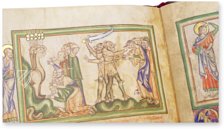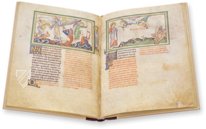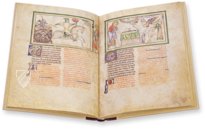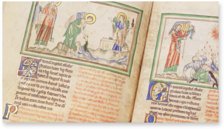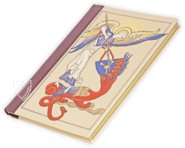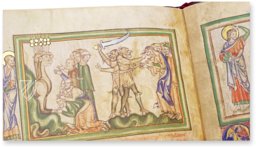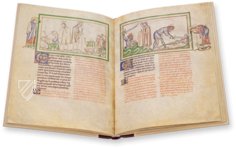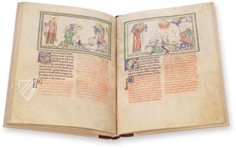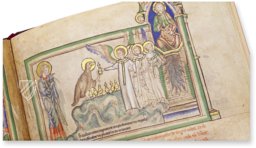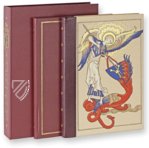Getty Apocalypse
(under 1,000€)
The so-called Getty Apocalypse, named after the J. Paul Getty Museum where it is stored, belongs among the highpoints of 13th English illumination. Impressive miniatures illustrate the extraordinary tales of the Book of Revelation. The powerful biblical text is supplemented with the accompanying Berengaudus Commentary from the 11th century. In each case, a framed half-page miniature illustrates the respective text passages. The depictions stand firmly in the tradition of English Gothic, with graceful figures and wonderfully vivid landscapes. The pictorial adornment of the manuscript is crowned by the countless splendidly historiated initials. The narrative force of the Apocalypse is visualized through the connection with the miniatures from the hand of a great master. Today the Getty Apocalypse still impresses nearly every lover of medieval illumination.
Getty Apocalypse
The so-called Getty Apocalypse, named after the J. Paul Getty Museum where it is stored, belongs among the highpoints of 13th English illumination. Impressive miniatures illustrate the extraordinary tales of the Book of Revelation. The powerful biblical text is supplemented with the accompanying Berengaudus Commentary from the 11th century. In each case, a framed half-page miniature illustrates the respective text passages. The depictions stand firmly in the tradition of English Gothic, with graceful figures and wonderfully vivid landscapes. The pictorial adornment of the manuscript is crowned by the countless splendidly historiated initials. The narrative force of the Apocalypse is visualized through the connection with the miniatures from the hand of a great master. Today the Getty Apocalypse still impresses nearly every lover of medieval illumination.
The Fantastical Book of Revelation
The Apocalypse with the terrifying tales of the end of the world and the accompanying events fit wonderfully into the world view of the 13th century. This worldview was visualized in the illustrations of the Getty Apocalypse. The Book of Revelation is a powerful, poetic text, which inspired medieval illuminators to grandiose pictorial inventions. The visions of destroyed cities, fearsome dragons and apocalyptic creatures, battling knights, and an enthroned God are sometimes infused with fear, sometimes simply awe-inspiring. As one of the most beautiful illustrated manuscripts of the Book of Revelation, the Getty Apocalypse – probably originating ca. 1255 in London – gives a direct insight into the perception of this biblical prophecy in the 13th century.
Splendor and Terror in Color and Gold
The Getty Apocalypse collects an unbelievable pictorial adornment of 82 miniatures and 42 historicized initials across a total of 92 pages. The splendid English manuscript is considered to be a work of exceptional artistry. Gold and silver adorn the wonderfully and colorfully designed illustrations, which are always mounted in a green frame above the text. Elegant figures with slender statures in accordance with the Gothic style are shown in front of wonderful urban, natural, and fantastical settings. The qualitatively exceptional, high-quality colored drawings present scenes from the Book of Revelation. The often terrifying scenes are illustrated in wonderfully vivid depictions. For example, in the depiction of the flood, where, under a black Sun and an askew moon, the waves roll over the people in unbelievable audacity.
Outstanding Artwork of Gothic Illumination
The artist of the Getty Apocalypse proved himself to be an outstanding master of book illumination with his miniatures. Wonderful pictorial inventions and compositions enrich the manuscript. The scenes sometimes overlap the borders, which lends the depictions an additional liveliness. Also the figure of John accompanies every miniature as a narrator and direct link to the events. The artistic adornment of the book is additionally indicated by the 42 wonderful historicized initials. These are initial ornaments with representations from profane iconography, be they scenes from Aesop’s Fables or simple figures for the amusement and entertainment of the reader away from the terrifying pictures of the Apocalypse.
Cryptic Pictures
The respectively associated text in black ink can be read under the miniatures, accompanied by the Berengaudus Commentary to the Apocalypse. This clarifying text from the second half of the 11th by a monk named Berengaudus century accompanies the actual text of the Book of Revelation in red ink. In this way, the biblical text of the Book of Revelation, its explanation and interpretation from the 11th century, and the grandiose English illumination of the 13th century are combined in an exceptionally artistic masterpiece – the *Getty Apocalypse!
Codicology
- Alternative Titles
- Dyson Perrins Apocalypse
Getty-Apokalypse - Size / Format
- 92 pages / 31.5 × 23.1 cm
- Origin
- United Kingdom
- Date
- Ca. 1255
- Style
- Genre
- Language
- Script
- Gothic Textura Prescissa
- Illustrations
- 82 miniatures and numerous historiated initials
- Content
- The Book of Revelation and the Berengaudus Commentary
- Previous Owners
- Charles Fairfax Murray (1849–1919)
Charles William Dyson Perrins (1864–1958)
Hans P. Kraus, Sr. (1907–1988)
Dr. Peter Ludwig (1925–96) and Irene Ludwig (1927–2010)
German Prayer Book of the Margravine of Brandenburg
The Dragon Fighting the Just
Taking the form of a seven-headed dragon with seven crowns, Satan does battles with Christian soldiers on Earth after having been defeated and cast down by the archangel Michael during the War in Heaven. John, the author of the Book of Revelation, looks away from the carnage in horror: “And the dragon was enraged with the woman, and he went to make war with the rest of her offspring, who keep the commandments of God and have the testimony of Jesus Christ.” (Rev. 12:17)

Getty Apocalypse
The Opening of the Sixth Seal: The Great Earthquake
The opening of the Seven Seals brings about seven catastrophes, including a great earthquake at which point the sun turns black, the moon turns red, and the stars fall from the sky. This causes the people on earth to flee into caves seeking shelter from God’s wrath. In the lavish historiated initial, an archer takes aim at a bird with the face of a bearded man.
A lone king resigns himself to his fate and holds a scroll with the relevant passage: “Then the sky receded as a scroll when it is rolled up, and every mountain and island was moved out of its place. And the kings of the earth, the great men, the rich men, the commanders, the mighty men, every slave and every free man, hid themselves in the caves and in the rocks of the mountains” (Rev. 6:14–15)

#1 Getty Apocalypse
(under 1,000€)
- Treatises / Secular Books
- Apocalypses / Beatus
- Astronomy / Astrology
- Bestiaries
- Bibles / Gospels
- Chronicles / History / Law
- Geography / Maps
- Saints' Lives
- Islam / Oriental
- Judaism / Hebrew
- Single Leaf Collections
- Leonardo da Vinci
- Literature / Poetry
- Liturgical Manuscripts
- Medicine / Botany / Alchemy
- Music
- Mythology / Prophecies
- Psalters
- Other Religious Books
- Games / Hunting
- Private Devotion Books
- Other Genres
- Afghanistan
- Armenia
- Austria
- Belgium
- Belize
- Bosnia and Herzegovina
- China
- Colombia
- Costa Rica
- Croatia
- Cyprus
- Czech Republic
- Denmark
- Egypt
- El Salvador
- Ethiopia
- France
- Germany
- Greece
- Guatemala
- Honduras
- Hungary
- India
- Iran
- Iraq
- Israel
- Italy
- Japan
- Jordan
- Kazakhstan
- Kyrgyzstan
- Lebanon
- Liechtenstein
- Luxembourg
- Mexico
- Morocco
- Netherlands
- Palestine
- Panama
- Peru
- Poland
- Portugal
- Romania
- Russia
- Serbia
- Spain
- Sri Lanka
- Sweden
- Switzerland
- Syria
- Tajikistan
- Turkey
- Turkmenistan
- Ukraine
- United Kingdom
- United States
- Uzbekistan
- Vatican City
- A. Oosthoek, van Holkema & Warendorf
- Aboca Museum
- Ajuntament de Valencia
- Akademie Verlag
- Akademische Druck- u. Verlagsanstalt (ADEVA)
- Aldo Ausilio Editore - Bottega d’Erasmo
- Alecto Historical Editions
- Alkuin Verlag
- Almqvist & Wiksell
- Amilcare Pizzi
- Andreas & Andreas Verlagsbuchhandlung
- Archa 90
- Archiv Verlag
- Archivi Edizioni
- Arnold Verlag
- ARS
- Ars Magna
- ArtCodex
- AyN Ediciones
- Azimuth Editions
- Badenia Verlag
- Bärenreiter-Verlag
- Belser Verlag
- Belser Verlag / WK Wertkontor
- Benziger Verlag
- Bernardinum Wydawnictwo
- BiblioGemma
- Biblioteca Apostolica Vaticana (Vaticanstadt, Vaticanstadt)
- Bibliotheca Palatina Faksimile Verlag
- Bibliotheca Rara
- Boydell & Brewer
- Bramante Edizioni
- Bredius Genootschap
- Brepols Publishers
- British Library
- C. Weckesser
- Caixa Catalunya
- Canesi
- CAPSA, Ars Scriptoria
- Caratzas Brothers, Publishers
- Carus Verlag
- Casamassima Libri
- Centrum Cartographie Verlag GmbH
- Chavane Verlag
- Christian Brandstätter Verlag
- Circulo Cientifico
- Club Bibliófilo Versol
- Club du Livre
- CM Editores
- Collegium Graphicum
- Collezione Apocrifa Da Vinci
- Comissão Nacional para as Comemorações dos Descobrimentos Portugueses
- Coron Verlag
- Corvina
- CTHS
- D. S. Brewer
- Damon
- De Agostini/UTET
- De Nederlandsche Boekhandel
- De Schutter
- Deuschle & Stemmle
- Deutscher Verlag für Kunstwissenschaft
- DIAMM
- Droz
- E. Schreiber Graphische Kunstanstalten
- Ediciones Boreal
- Ediciones Grial
- Ediclube
- Edições Inapa
- Edilan
- Editalia
- Edition Deuschle
- Edition Georg Popp
- Edition Leipzig
- Edition Libri Illustri
- Editiones Reales Sitios S. L.
- Éditions de l'Oiseau Lyre
- Editions Medicina Rara
- Editorial Casariego
- Editorial Mintzoa
- Editrice Antenore
- Editrice Velar
- Edizioni Edison
- Egeria, S.L.
- Eikon Editores
- Electa
- Emery Walker Limited
- Enciclopèdia Catalana
- Eos-Verlag
- Ephesus Publishing
- Ernst Battenberg
- Eugrammia Press
- Extraordinary Editions
- Fackelverlag
- Facsimila Art & Edition
- Facsimile Editions Ltd.
- Facsimilia Art & Edition Ebert KG
- Faksimile Verlag
- Feuermann Verlag
- Folger Shakespeare Library
- Franco Cosimo Panini Editore
- Friedrich Wittig Verlag
- Fundación Hullera Vasco-Leonesa
- G. Braziller
- Gabriele Mazzotta Editore
- Gebr. Mann Verlag
- Gesellschaft für graphische Industrie
- Getty Research Institute
- Giovanni Domenico de Rossi
- Giunti Editore
- Graffiti
- Grafica European Center of Fine Arts
- Guido Pressler
- Guillermo Blazquez
- Gustav Kiepenheuer
- H. N. Abrams
- Harrassowitz
- Harvard University Press
- Helikon
- Hendrickson Publishers
- Henning Oppermann
- Herder Verlag
- Hes & De Graaf Publishers
- Hoepli
- Holbein-Verlag
- Houghton Library
- Hugo Schmidt Verlag
- Idion Verlag
- Il Bulino, edizioni d'arte
- ILte
- Imago
- Insel Verlag
- Insel-Verlag Anton Kippenberger
- Instituto de Estudios Altoaragoneses
- Instituto Nacional de Antropología e Historia
- Introligatornia Budnik Jerzy
- Istituto dell'Enciclopedia Italiana - Treccani
- Istituto Ellenico di Studi Bizantini e Postbizantini
- Istituto Geografico De Agostini
- Istituto Poligrafico e Zecca dello Stato
- Italarte Art Establishments
- Jan Thorbecke Verlag
- Johnson Reprint Corporation
- Josef Stocker
- Josef Stocker-Schmid
- Jugoslavija
- Karl W. Hiersemann
- Kasper Straube
- Kaydeda Ediciones
- Kindler Verlag / Coron Verlag
- Kodansha International Ltd.
- Konrad Kölbl Verlag
- Kurt Wolff Verlag
- La Liberia dello Stato
- La Linea Editrice
- La Meta Editore
- Lambert Schneider
- Landeskreditbank Baden-Württemberg
- Leo S. Olschki
- Les Incunables
- Liber Artis
- Library of Congress
- Libreria Musicale Italiana
- Lichtdruck
- Lito Immagine Editore
- Lumen Artis
- Lund Humphries
- M. Moleiro Editor
- Maison des Sciences de l'homme et de la société de Poitiers
- Manuscriptum
- Martinus Nijhoff
- Maruzen-Yushodo Co. Ltd.
- MASA
- Massada Publishers
- McGraw-Hill
- Metropolitan Museum of Art
- Militos
- Millennium Liber
- Müller & Schindler
- Nahar - Stavit
- Nahar and Steimatzky
- National Library of Wales
- Neri Pozza
- Nova Charta
- Oceanum Verlag
- Odeon
- Orbis Mediaevalis
- Orbis Pictus
- Österreichische Staatsdruckerei
- Oxford University Press
- Pageant Books
- Parzellers Buchverlag
- Patrimonio Ediciones
- Pattloch Verlag
- PIAF
- Pieper Verlag
- Plon-Nourrit et cie
- Poligrafiche Bolis
- Presses Universitaires de Strasbourg
- Prestel Verlag
- Princeton University Press
- Prisma Verlag
- Priuli & Verlucca, editori
- Pro Sport Verlag
- Propyläen Verlag
- Pytheas Books
- Quaternio Verlag Luzern
- Reales Sitios
- Recht-Verlag
- Reichert Verlag
- Reichsdruckerei
- Reprint Verlag
- Riehn & Reusch
- Roberto Vattori Editore
- Rosenkilde and Bagger
- Roxburghe Club
- Salerno Editrice
- Saltellus Press
- Sandoz
- Sarajevo Svjetlost
- Schöck ArtPrint Kft.
- Schulsinger Brothers
- Scolar Press
- Scrinium
- Scripta Maneant
- Scriptorium
- Shazar
- Siloé, arte y bibliofilia
- SISMEL - Edizioni del Galluzzo
- Sociedad Mexicana de Antropología
- Société des Bibliophiles & Iconophiles de Belgique
- Soncin Publishing
- Sorli Ediciones
- Stainer and Bell
- Studer
- Styria Verlag
- Sumptibus Pragopress
- Szegedi Tudomànyegyetem
- Taberna Libraria
- Tarshish Books
- Taschen
- Tempus Libri
- Testimonio Compañía Editorial
- Thames and Hudson
- The Clear Vue Publishing Partnership Limited
- The Facsimile Codex
- The Folio Society
- The Marquess of Normanby
- The Richard III and Yorkist History Trust
- Tip.Le.Co
- TouchArt
- TREC Publishing House
- TRI Publishing Co.
- Trident Editore
- Tuliba Collection
- Typis Regiae Officinae Polygraphicae
- Union Verlag Berlin
- Universidad de Granada
- University of California Press
- University of Chicago Press
- Urs Graf
- Vallecchi
- Van Wijnen
- VCH, Acta Humaniora
- VDI Verlag
- VEB Deutscher Verlag für Musik
- Verlag Anton Pustet / Andreas Verlag
- Verlag Bibliophile Drucke Josef Stocker
- Verlag der Münchner Drucke
- Verlag für Regionalgeschichte
- Verlag Styria
- Vicent Garcia Editores
- W. Turnowski Ltd.
- W. Turnowsky
- Waanders Printers
- Wiener Mechitharisten-Congregation (Wien, Österreich)
- Wissenschaftliche Buchgesellschaft
- Wissenschaftliche Verlagsgesellschaft
- Wydawnictwo Dolnoslaskie
- Xuntanza Editorial
- Zakład Narodowy
- Zollikofer AG






